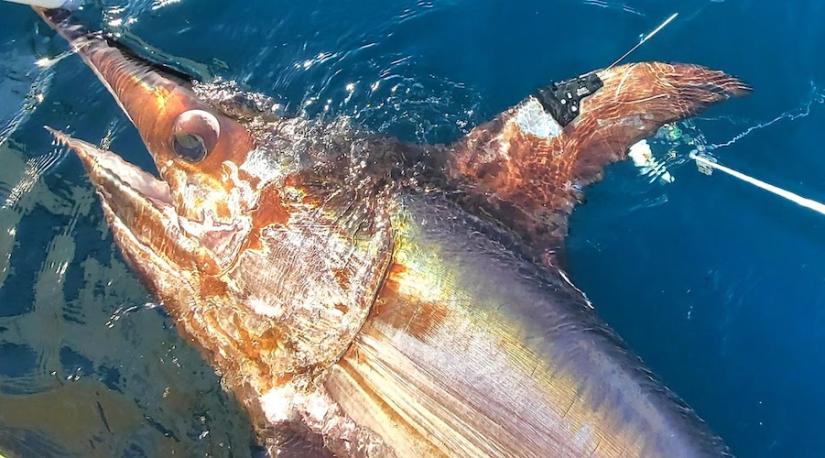California has a long history of fishing for and consuming swordfish, revered as a delicacy in fine dining restaurants. In California, the swordfish industry peaked shortly after it began in the mid-1980s and has since gradually declined in both participation and landings. Today, the multi-million dollar industry in the United States feeds consumers roughly 20 million pounds of swordfish each year. Predominantly consumer demand is in California with most of the consumed swordfish being imported — up to 80 percent. In recent years, the California swordfish fishery has turned a corner and shifted to using cleaner, deep-set techniques, which have proven to be less destructive than traditional swordfish operations. The advent and growing use of novel techniques has begun to offer U.S. consumers with additional sustainable menu choices.

Growing to more than 10 feet in length, the Pacific swordfish ranges from the surface waters to depths well below 2,000 feet. A formidable target for many anglers, its prowess is unmatched by most species, making it uniquely challenging to catch as it pushes fishing gear to its limits.
The swordfish is a global commodity, with movements shown to cross significant swaths of ocean. However, technology used to track swordfish migration patterns is limited, requiring researchers to base annual migrations and seasonal movements on incomplete data. Fishing pressures in other parts of the world directly impact California’s ability to manage and conserve migratory species, making it imperative to understand the movements of swordfish for effective management.
The research team led by Chugey Sepulveda, a scientist with the Pfleger Institute of Environmental Research (PIER), is employing technological advancements to track and study the movements and genetics of swordfish to document annual migration cycles and promote sustainable management. The collaborative project between NOAA, Texas A&M and PIER is partially funded by the California Ocean Protection Council’s Proposition 84 Competitive Grants Program and is administered by California Sea Grant.
“This research has always been important. However, we haven't had the tools or technology to address questions of stock structure and annual migration patterns,” Sepulveda says. “We’ve just now developed the capacity to address this question for swordfish, and I am certain that these techniques will help address the same questions for other species as well.”
Scientists know swordfish forage off the coast of California from roughly July through January and spawn further south in tropical waters off Hawaii and along the Mexican and Central American coast during the springtime. But documenting the migration corridors and comparing them to the models currently used to manage swordfish in the North Pacific Ocean remains a major goal of Sepulveda’s project. Historically, scientists have relied on fishery-dependent data but as technology advances, scientists will be able to manage swordfish stocks with precise movement data. This will be particularly relevant to regions with more than one stock of swordfish with variations in productivity or population status, such as those off the coast of California.
“By tracking swordfish movement patterns, we can see exactly where they go, propose where adults spawn and also identify which stocks we are harvesting from,” says Sepulveda.
Accurate movement and stock structure data are critical for sustainably managing any marine resource, especially one that can migrate thousands of miles annually throughout the Pacific Ocean.
This study is the first to document multiyear migration patterns for swordfish and will test whether the current North Pacific Ocean swordfish stock structure hypotheses are accurate — that two independent stocks of swordfish (the Western and Central North Pacific stock, and the Eastern Pacific Ocean stock) are found in the eastern North Pacific Ocean.
During this study, Sepulveda and his team have tagged over 50 swordfish with electronic transmitters that report position every time the swordfish comes to the surface to bask. The transmitters can be used to track movements over the course of two to three years, providing an ideal dataset for assessing stock structure and regional affinity, providing superior innovation to previous technologies used to document swordfish migration routes.
The team has also collected genetic tissues, which are being analyzed by researchers at the Alvarado-Bremer Laboratory at Texas A&M University. The goal is to compare fish with known migration patterns to assess if genetics can help differentiate North Pacific Ocean stocks. Preliminary results suggest swordfish off the coast of California do not adhere strictly to the current models used to manage the species in the Pacific Ocean.
As California continues to harvest swordfish and other species, it is increasingly important that we know where our seafood comes from. As a result, consumers can reward domestic industries that adhere to sustainable harvest practices.
About California Sea Grant
NOAA’s California Sea Grant College Program funds marine research, education and outreach throughout California. Headquartered at Scripps Institution of Oceanography at the University of California San Diego, California Sea Grant is one of 34 Sea Grant programs in the National Oceanic and Atmospheric Administration (NOAA), U.S. Department of Commerce.